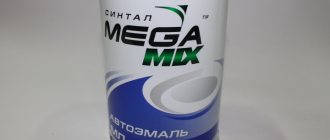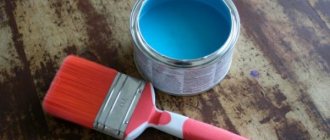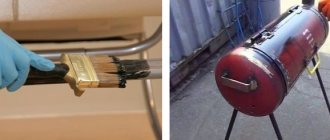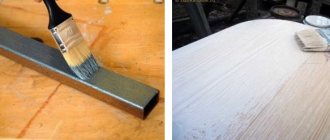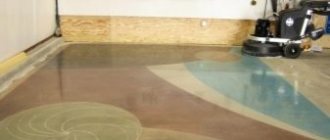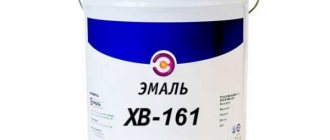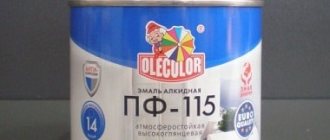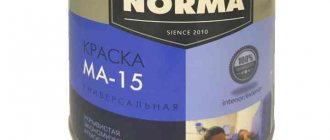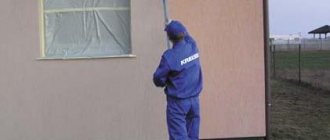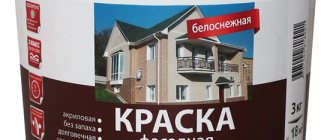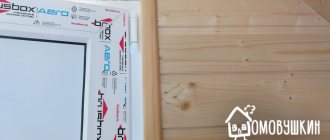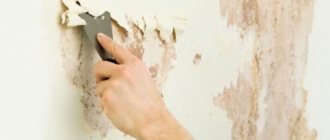Water-based paints (WE) are traditionally used for painting interior walls and ceilings. Unlike oil paints, they form a vapor-permeable, “breathable” layer, creating a comfortable microclimate in the room. Today, the most popular are emulsions with the addition of polymer (acrylic) resins . These include water-based paint VEAK-1180. The abbreviation stands for: - water-based, AK - acrylic-containing. A layer of such paint, while fully maintaining its vapor permeability, can withstand 5000 cycles of wet cleaning with detergents.
Main advantages
Among the main advantages of this material are low consumption, excellent adhesion to high-quality prepared surfaces, high environmental friendliness and the complete absence of any odors, lack of toxicity, and non-flammability.
Also, this water-based paint is durable. After working with paint, the tool can be easily cleaned with plain water.
Due to its high technical characteristics, VEAC 1180 is well suited for working with any surface. The paint can be used with any coating, for painting wallpaper and applying to old finishes. This does not apply to metal and glossy surfaces.
LKM is also easy to use. You can also use plain water to clean the painted surface. When working with these mixtures, a smooth matte surface is formed. Interior paints of this brand are suitable for interior work in any structures and buildings.
Due to its high characteristics, this paint is used for painting surfaces in rooms with high humidity levels.
BRANDS AND TECHNICAL REQUIREMENTS
1. BRANDS AND TECHNICAL REQUIREMENTS
1.1. Depending on the composition and purpose of the paint, the following brands are available:
VD-VA-224 - based on homopolymer polyvinyl acetate dispersion for indoor work, as well as rooms with high humidity (kitchens, bathrooms, toilets);
VD-KCh-26A, VD-KCh-26 - based on styrene-butadiene latex for indoor work (paint brand VD-KCh-26A - using titanium dioxide, paint brand VD-KCh-26 - lithopone);
VD-AK-111, VD-AK-111r - based on copolymer acrylate dispersion for external and internal painting of buildings and structures (VD-AK-111r is used to produce relief paint);
VD-KCh-183 - based on aqueous dispersions of synthetic polymers, for exterior painting of buildings and structures and interior finishing work (except for surfaces subject to intensive washing);
VD-KCh-577 - based on aqueous dispersions of synthetic polymers for painting fruit, ornamental trees and shrubs in order to increase their winter hardiness, protect against sunburn, protect against rodents and cover wounds.
1.2. Water-dispersion paints must be manufactured in accordance with the requirements of this standard according to recipes and technological regulations approved in the prescribed manner.
1.3. Characteristics
1.3.1. Paints must comply with the requirements and standards specified in Table 1.
Table 1
| Indicator name | Standard for brands | Test method | ||||||
| VD-VA-224 | VD-KCH-26A | VD-KCH-26 | VD-AK-111 | VD-AK-111r | VD-KCH-183 | VD-KCH-577 | ||
| OKP 23 1611 1001 | OKP 23 1621 0201 | OKP 23 1621 0101 | OKP 23 1631 0101 | OKP 23 1632 0243 | 23 1621 0401 | OKP 23 1621 0500 | ||
| 1. Paint film color: | Must be within the permissible deviations established by the “Card Index” color samples (standards) or control color samples | According to clause 4.3 | ||||||
| white | Must be within the permissible deviations established by control samples | — | Must be within the permissible deviations established for control samples | |||||
| pale pistachio | — | — | — | — | 345, 346 | — | ||
| 2. Appearance of the film | After drying, the paint should form a film with a smooth, uniform matte surface. | According to clause 4.3 | ||||||
| 3. Mass fraction of non-volatile substances, % | 53-59 | 52-57 | 56-61 | 52-57 | 47-52 | 52-57 | 55-60 | According to GOST 17537 and clause 4.4 of this standard |
| 4. Paint pH | 6,8-8,2 | Not less than 9.0 | Not less than 9.0 | 8,0-9,0 | 7,5-9,5 | Not less than 8.0 | Not less than 6.5 | According to clause 4.5 |
| 5. Covering power of the dried film, g/m, no more | 120 | 140 | 210 | 100 | 80 | 120 | 180 | According to GOST 8784, sections 1, 2 and clause 4.6 of this standard |
| 6. Resistance of the film to the static effects of water, at a temperature of (20±2) °C, h, not less | 12 | — | — | 24 | 24 | 24 | — | According to GOST 9.403, method A and clause 4.7 of this standard |
| 7. Frost resistance of paint, cycles, not less | 5 | 5 | 5 | 5 | 5 | 5 | 5 | According to clause 4.8 |
| 8. Conditional light fastness (change in diffusion reflection coefficient), %, no more | — | — | — | 5 | 5 | 5 | — | According to GOST 21903, method 2 and clause 4.9 of this standard |
| 9. Degree of grinding, microns, no more | 30 | 70 | 70 | 60 | 60 | 60 | 60 | According to GOST 6589* |
| 10. Drying time to degree 3 at temperature (20±2) °C, h, no more | 1 | 1 | 1 | 1 | 1 | 1 | 1 | According to GOST 19007 |
_______________ * The document is not valid on the territory of the Russian Federation. GOST R 52753-2007 is valid. — Note from the database manufacturer.
(Changed edition, Amendment No. 1).
1.3.2. Additional characteristics of paints are given in Appendix 1.
(Introduced additionally, Amendment No. 1).
1.4. Packaging - according to GOST 9980.3.
1.5. Marking - in accordance with GOST 9980.4 with the application of a manipulation sign “Temperature Limitation” in accordance with GOST 14192.
(Changed edition, Amendment No. 1).
Technical characteristics of VEAK-1180 paint
Acrylic emulsion is produced in accordance with GOST 19214-80 and is intended for work on concrete and brick surfaces (plastered and unplastered), primed metal and old coatings. Material specifications:
- suspension density - 1.4 g/cm?;
- conditional viscosity at t 20 degrees - from 30 m?/s;
- hiding power - 120 g/m.
- consumption for the first layer - 150 g/m?;
- drying time to degree 3 (when the second layer can be applied) - 1 hour;
- water resistance - 12;
- frost resistance - at least 5 cycles;
- Ph composition - from 6.8 to 8.2;
- adhesion to surface - 2 points;
- abrasion resistance - 3.5 microns/kg;
- maximum size of paint particles (grinding degree) - 30 microns;
- mass fraction of non-volatile compounds - from 53 to 59%.
Freezing does not affect the properties of the paint. Before use, defrost it at room temperature. If it thickens, dilute with clean water to the required consistency.
Work technology
The material must be brought to room temperature and, if necessary, defrosted. Next, the mass is mixed until homogeneity is achieved; if the consistency is increased, it is diluted with water to the standard viscosity. Thick paint lays down unevenly, liquid paint leaves unpainted streaks, so proper dilution is a very important step. It is forbidden to introduce solvents - this will immediately spoil the composition. The surface is cleaned and primed in advance.
If painting with white color is necessary, use material without tinting. Typically, white paint is in demand on ceilings. Otherwise, tinting is applied according to the selected shade. There is a list of colors of certain brands that are best combined with this water-based enamel. This:
- Dufa D230″;
- Tints Dulux (England);
- Russian tinting “Unicolor”, Dali, Palizh.
The cost of tinting pastes is 20-100 rubles, domestic ones are usually cheaper. There is no need to add a lot of color, as this impairs the adhesion and other qualities of the base material. Inorganic pigments are considered the most resistant to light, but the variety of their shades is small. Organic colorants are brighter but fade faster. Therefore, the first type of colors is usually used on facades, the second - indoors.
Coloring
Painting is carried out using a spray gun, roller, brush. Work the brush slowly, but in places with difficult access it is irreplaceable. Using a spray gun, the material will be applied evenly, without excess or smudges. You can work with a roller without unnecessary costs. The first coat applied must dry for at least an hour before applying a second coat (if necessary). The temperature indoors or outdoors is not lower than +20 degrees.
Tools
As already noted, the work will require a brush, roller or paint sprayer. If you decide to paint with a brush, choose rectangular shapes with not too thick bristles. The roller should have soft, long pile; foam rubber will not work - it creates bubbles. It is better to buy a spray gun if the area of the room is large, since this device will allow you to paint up to 150 square meters of area in an hour.
Technology of working with paint VEAK-1180
Tinting the composition
The standard paint color is snow white. However, using color, you can achieve any desired shade. The following pigments are suitable for paint (approximate price is indicated for 100 ml):
- Parade, Russia - 23 rubles;
- Dali, Russia - 25 rubles;
- Tex tinting paste, Russia - 35 rubles;
- Palizh, Russia - 40 rubles;
- Unicolor, Russia - 45 rubles;
- Dufa D 230, Germany - 50 rubles;
- Dulax, UK - 90 rubles;
Here we must remember that a large amount of color impairs the technical properties of water-based paint. Organic dyes have bright colors, but fade quickly. Inorganic colorants, on the contrary, are lightfast, but pale, with a limited palette.
Staining order
The consumption of water emulsion depends on how well the surface is prepared. The walls and ceiling should be cleaned, puttyed and primed. To do this, use a deep penetration acrylic primer.
Certificate of conformity
This is a document confirming the compliance of a certain product with the standards of its production prescribed in GOST. The certificate of conformity must indicate:
- physical and legal paint production address;
- certificate validity date;
- results of tests and laboratory checks of paint composition;
- checklist.
The authenticity of the certificate is ensured by the seal and signature.
The certificate guarantees the buyer the purchase of high-quality enamel that will meet the stated technical parameters. You can request the document from the seller in the store, and they must provide it to you.
Composition and labeling
The main component of VEAK is acrylic dispersion, so the enamel belongs to the category of acrylic. According to the percentage of paint components, the situation is as follows:
- acrylic dispersion makes up half of the total paint and varnish material (50%);
- plasticizers to increase elasticity properties – 7%;
- pigment to give the paint a white color – 37%;
- other additives to ensure the quality characteristics of enamel (thickeners, preservatives, defoamers, etc.) – 6%.
In most cases, the thickener is KLC glue.
In order to increase resistance to moisture, some manufacturers add latex to the composition.
Marking:
- VE - water-based;
- AK – acrylic-containing.
VEAK paint tinting
Since the color of the paint is white, dyes are needed to give it color. It is very important to choose the right not only paint, but also the color for it. The quality of the composition depends on the manufacturer. Below is a list of recommended colors:
- German Dufa D230;
- English color from Dulux;
- domestic companies: Palizh, Unicolor, Dali, Parade.
You shouldn't use too much pigment. This may adversely affect the performance of the composition. Inorganic colors are used for facade work. Their shades are pale, however, they do not fade in the sun. To give a rich shade to the interior, organic-based products are used. Their UV resistance is much worse.
Note! Application of the composition is carried out in different ways.
The slowest one is with a paint brush. The advantage is that it allows you to treat hard-to-reach places. It's faster and more convenient to work with a roller. But it is effective on flat and large surfaces. The ideal option is a spray gun. The paint is applied evenly, quickly and without smudges.
SAFETY REQUIREMENTS
2.1. Water-dispersion paints are fire and explosion proof.
2.2. During the production, testing and use of paints, fire safety and industrial sanitation requirements in accordance with GOST 12.3.005 must be observed.
2.3. All work with paint must be carried out in rooms equipped with supply and exhaust ventilation, ensuring the air condition of the working area in accordance with GOST 12.1.005.
2.4. The maximum permissible concentrations and hazard class of vapors of monomers and paint components are given in Table 2.
table 2
| Component name | Maximum permissible concentration, mg/m* | Hazard Class | ||
| in the air of the working area of the production premises | in the water of reservoirs | in the atmosphere | ||
| Polyvinyl acetate dispersion: | ||||
| on vinyl acetate | 10 | 0,2 | 0,15 | 3 |
| by acetaldehyde | 5 | 0,2 | 0,01 | 3 |
| on dibutyl phthalate | 0,5 | 0,2 | — | 2 |
| Latex butadiene nitrile: | ||||
| for acrylonitrile | 0,5 | 2,0 | 0,03 | 2 |
| Styrene-butadiene latex: | ||||
| for styrene | 30/10 | 0,1 | 0,003 | 3 |
| Emulsion MBM-5s: | ||||
| by methyl methacrylate | 10 | 0,01 | 0,1 | 3 |
| for butyl acrylate | 10 | 0,01 | — | 3 |
| for methacrylic acid | 10 | 1,0 | — | 3 |
| Ethylene glycol | 5 | 1,0 | — | 3 |
| Thiuram: (tetramethylthiuram disulfide) | 0,5 | 1,0 | 0,006 | 2 |
| Aerosil | 1,0 | — | — | 3 |
| Pentachlorophenolate | 0,1 | 5,0 | 0,001 | 1 |
| White Spirit | 300 | — | — | 4 |
| Titanium dioxide | 10 | — | — | 4 |
________________ * Probably an error from the original. Should read: mg/m. — Note from the database manufacturer.
2.5. The harmful substances that make up the paint have a toxic effect on the hematopoietic organs, nervous system, skin, mucous membranes of the eyes and respiratory tract. The dried coating has no harmful effects on the human body.
2.4, 2.5 (Changed edition, Amendment No. 1).
2.6. Persons associated with the manufacture, testing and use of paints must be provided with special clothing and personal protective equipment in accordance with GOST 12.4.011 and GOST 12.4.103.
2.7. Monitoring compliance with maximum permissible emissions (MPE) into the atmosphere, approved in accordance with the established procedure, must be carried out in accordance with GOST 17.2.3.02.
Choosing quality paint
In one hardware store you can see several types of VEAK 1180 from different manufacturers. Some brands are more expensive, others are cheap. Price will not always be the determining factor for a purchase. Sometimes inexpensive domestic ones serve no worse than imported ones, the price of which consists of duties and expensive transportation
To purchase a quality product, it is important to clarify whether there is a certificate of conformity indicating:
- purpose of the material;
- GOST parameters;
- passed checks.
The shelf life must be in order - water-based paints lose their properties and peel off if the storage period is exceeded. The packaging must not be damaged or wrinkled. For the rest, you can rely on the opinions of professionals, store consultants or online users.
https://knigastroitelya.ru/materialy/kraska-vodoemulsionnaya-veak-1180-texnicheskie-xarakteristiki-i-cena.htm https://kraskaved.com/kraski/tipy/alkidnaja/masljanaja/vodoemulsionnaja.html https:// www.kistivruki.ru/catalog/kraska/vodoemulsionnaya-akrilovaya-veak-1180.html https://online.zakon.kz/Document/?doc_id=30117365 https://kraska.guru/kraski/vidy/vodoemulsionnaya-veak -1180.html
Details
Tinting paints and varnishes
Since the color of the paint is white, dyes are required to give the required shade. It is very important to choose a paint and not only it, but also a color for it. The quality of the composition will depend on the manufacturer.
Below is a list of recommended tints:
German Dufa D230.- English-made tinting from Duluh.
- Domestic companies - Parade, Palizh, Dali and Unisolor.
Please note that you should not use too much pigment. This may negatively affect the performance of the composition. For facade work, inorganic colors are used, and they have pale shades, however, they will not fade in the sun. To give a rich shade to the interior, you should use organic-based products. Their UV resistance is much worse. Please note that the composition is applied using various methods. The slowest way is to apply it with a paint brush. The advantage of this method is that it will allow you to process hard-to-reach places, and it will be more convenient and faster to work with a roller. This is effective for large, flat surfaces, and a spray gun is ideal. In this case, the paint and varnish composition will be applied evenly, without smudges and quickly.
Criteria for selecting coatings
Water-based paint VEAC 1180 is popular, and there are many manufacturers of such material. And construction stores are also filled with different options. Some of them are much cheaper and unpopular, while others are much more expensive and well-known. It is clear that for such a thing it is not worth saving. It is better to choose a material of a proven type, which has many positive reviews and has proven itself well. The main sign of high-quality material is the presence of a certificate of conformity. If the store can provide it, then this is a great sign. What should be described in the certificate for water-based paint?
Similar data:
- Marking according to GOST.
- Address of the plant where the product was manufactured (actual and legal).
- List of surfaces for which water-based paint is suitable.
- Tests that the paint composition has passed.
- The certificate must be certified by a signature and seal from higher authorities.
When purchasing, you should also pay attention to the packaging itself, because in no case should it be damaged - neither the jar nor the label. Don't forget to check the expiration date, and it's worth remembering that the most expensive is not always the best.
Painting
Walls are painted in three layers: the first is primer, the next two are paint and varnish.
Painting is carried out in stripes overlapping each other at the junction in the manner of writing the letter “W”.
It is better to start work in daylight in the direction from the window in the opposite direction.
How to prepare a wall for painting
The preliminary stage includes plastering the uneven walls, then applying a layer of putty. After the materials have dried, the walls are washed with soapy water and a layer of primer is applied.
Popular Technologies
There are three main technologies for painting walls:
- brush;
- roller;
- spray gun.
Brush painting is an energy-intensive process with less than ideal results. The brush applies the paint unevenly and leaves streaks. However, you cannot do without a brush when processing areas in corners, at the joints with the ceiling, and around window frames. To do this, you need to choose a brush 10-15 cm wide, immerse it in liquid up to a third of the bristles, and use a mesh to get rid of excess on the brush.
Painting with a roller is a quick method that requires care in distributing the paint, first on the roller itself, then on the wall to avoid drips and splashes. To do this, use a special tray with a container for water emulsion and a place for rolling.
The use of a spray gun gives a high-quality layer without streaks, omissions, smudges, or color differences. The device is characterized by a large simultaneous coverage of the wall area, which speeds up the painting process.
How to paint over old paint
It is possible to update the interior without bothering to remove the old coating only if the old paint does not peel off. For a new coating with water-based emulsion, you need to sand the wall, apply a primer layer, and then start painting.
If the old paint is covered with cracks, chips, or peeling places, then for better adhesion of the new coating it must be removed. The water-dispersion coating can be washed off with a special solvent, or mechanically using a spatula, chisel, grinder, hair dryer, etc.
How to apply to different surfaces
You can paint wallpaper, textured plaster, plasterboard structures, and old finishes with oil paint with a water-dispersion emulsion. Each of these cases requires an individual solution.
You can paint wallpaper that is specially marked “for painting”!
Others may behave unpredictably under the coloring composition - get wet, change the degree of smoothness of the surface, peel off from the wall, absorb the paint unevenly, creating streaks.
Plasterboard walls are becoming more popular due to the variety of shapes they can create and their smooth surface.
This simplifies the process of wallpapering, but painting requires a number of manipulations.
Painting of drywall is possible when applied to a layer of finishing putty. The layer of putty here can be minimal, since it is intended not to level, but to create a uniform surface without seams and putty at the joints to obtain a uniform color in just one layer of paint.
You should not apply water-based emulsion to whitewashed surfaces - it is better to wash off the whitewash first. Chalk or lime compounds will begin to crack and peel under the paint, forcing you to repaint the walls once a year.
How to remove old finishes and is it allowed to paint over whitewash and oil paint?
Water-based paint for wall finishing
If you need to remove the old water-based finish, it is better to immediately use a sander. However, this method is more often used if the paint is washable. It is better to remove the coating by first soaking it with water and diluting iodine. Dilute warm water with iodine to increase the effect of the material lagging from the surface. Next, use a putty knife to remove all the old finish.
Many people use a chemical method to remove the finish. This is an improved version, however, and costs a little more. Wash off using reagents simply and quickly; just apply them to the wall and wait up to 30 minutes. After this, washing off the finish will not be difficult. It’s up to you to decide which way to remove the water-based mixture; it all depends on whether it’s washable or not.
Many materials are not recommended to be applied over whitewash, but if you decide to paint with water-based emulsion over whitewash, then be sure of the quality of the old coating. It is not necessary to prime the surface. But painting with oil is a controversial issue. Many people do not advise painting over oil paint, and in this case I agree that it is easier to remove the coating than to properly prepare it for new painting.
Manufacturers
Products from different manufacturers may differ slightly in technical specifications. Thus, AQUA paint has a slightly lower viscosity level. But at the same time, the product has the highest adhesion. Five hours is enough for complete drying.
Related article: Aluminum-based paint BT 177 and its characteristics
EPOXY paint takes up to a day to dry completely. The Fontecoat product dries in 16 hours. “AQUA” also has the lowest consumption – 135 g/m2.
The price depends on the composition and technical characteristics. Thus, interior paint has an average cost of 45 rubles. for 1 kg. Facade coatings – from 55 rub. Universal materials - 55 rubles, products for exterior finishing have an average price of 65 rubles. There are also inexpensive analogues on the market, these are products from Lakra, Vaksa.
Customer Reviews
It is impossible to judge water-based products solely by technical characteristics and written advantages. It is important to find out what users who have already used it say about VEAC 1180 water-based paint.
Nikolai, construction foreman: “It has always been more convenient and easier to work with water-based emulsion than with lime. And it’s easier to tint paintwork materials. One day, water-based paint VEAC 1180 was brought to our site. That was the first time I worked with it. After opening the package, we prepared the composition by adding water and coloring. The result is a light coffee shade. In one shift, 6 apartments were sprayed. VEAC 1180 paint applies smoothly, does not splash or leak. Has good hiding power. True, during operation the water emulsion has to be constantly stirred. But this did not stop us from quickly completing all the work.”
Victor, developer: “I couldn’t decide what type of interior decoration to choose for the cottage. I read a lot of information and settled on painting. Cheap and cheerful. I painted the walls and ceiling with acrylic-based emulsion VEAC 1180. I was pleased with the result. An experienced designer created pearl, blue and pistachio colors VEAC 1180, perfectly combining them with each other. Moreover, he argued that if his wife didn’t like it, then painting the walls would not be a problem. As a result, my wife approved, the surface is smooth, has no sagging or smudges. Beautiful matte color that has lasted for 3 years. I recommend water-based paint VEAC 1180.”
